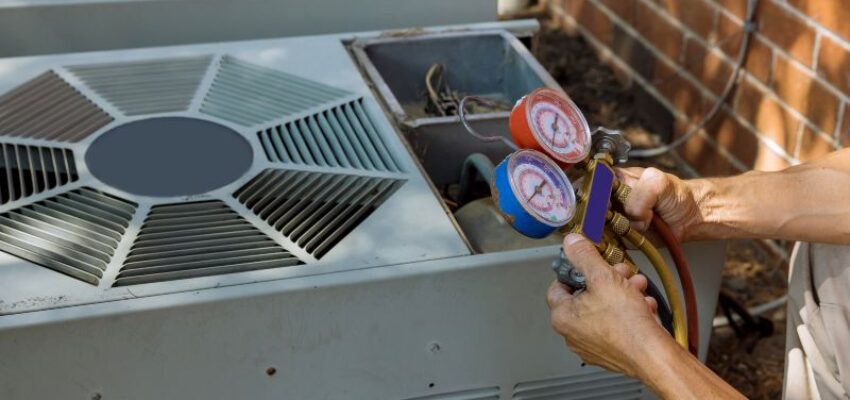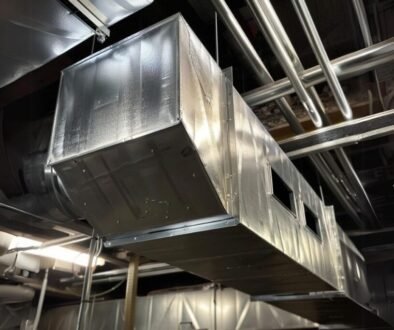Understanding Your Airconditioner: The Basic Parts of an AC Unit

Published July 31, 2023
Air conditioners are crucial in staying cool and comfortable during hot summer days. These machines work tirelessly to regulate the temperature of our living spaces. Have you ever wondered about the inner workings of an air conditioner?
In this article, we will look into the essential parts of an AC unit. We are shedding light on their functions and importance.
5 Air Conditioning Components
1. Evaporator Coil
The evaporator coil is a vital component of an air conditioner. It is located inside the indoor unit and is crucial in cooling the air. This coil contains a refrigerant. This absorbs heat from the surrounding air.
Uses:
- Absorbs heat from the surrounding air for cooling.
- Facilitates the exchange of heat between the refrigerant and the indoor air.
2. Compressor
The compressor is often referred to as the heart of an air conditioner. It handles pressurizing the refrigerant and circulating it through the system. By compressing the refrigerant, the compressor releases heat more efficiently.
Uses:
- Releases the heat absorbed by the refrigerant.
- Facilitates the heat dissipation process by blowing air over the coil.
3. Condenser Coil
The condenser coil is located in the outdoor unit of an air conditioner. Its primary function is to dissipate heat absorbed by the refrigerant. As the refrigerant flows through the condenser coil, a fan blows air over it.
Uses:
- Releases the heat absorbed by the refrigerant.
- Facilitates the heat dissipation process by blowing air over the coil.
4. Expansion Valve
The expansion valve regulates the flow of refrigerant into the evaporator coil. It controls the pressure and temperature of the refrigerant. It ensures it is in the right state to absorb heat from the air passing over the evaporator coil.
Uses:
- Regulates the flow of refrigerant into the evaporator coil.
- Controls the pressure and temperature of the refrigerant to optimize cooling efficiency.
5. Air Filter
While not a direct part of the cooling process, the air filter is a crucial component of an air conditioner. It captures dust, pollen, and other airborne particles. A clean air filter ensures optimal performance and efficiency.
Uses:
- Captures dust, pollen, and other airborne particles, improving indoor air quality.
- Ensures optimal performance and efficiency of the AC unit. It keeps the system clean and prevents clogs.

Parts of an HVAC system
1. Thermostat
The thermostat is the control center of your air conditioner. It allows you to set the desired temperature and regulates the cooling process.
2. Evaporator Coil
The evaporator coil handles absorbing heat from the indoor air. It is located in the indoor unit of the AC system. It cools down the air by circulating refrigerant through its fins.
3. Condensing Unit
The condensing unit is the outdoor component of the AC system. It houses the compressor, condenser coil, and fan. The condenser coil releases the heat absorbed by the evaporator coil into the outdoor air.
4. Compressor
The compressor is often called the “heart” of the air conditioner. It pressurizes the refrigerant. This increases its temperature and prepares it for the heat exchange process.
5. Refrigerant Lines
These copper tubes connect the indoor and outdoor units of the AC system. It carries the refrigerant back and forth between the two.
6. Blower Motor
The blower motor handles circulating the conditioned air throughout your home or building. It pushes the air through the ductwork system and into the different rooms.
7. Filter
The filter helps remove dirt and particles from the air. Regularly cleaning or replacing the filter is essential. This will maintain good indoor air quality and efficient AC operation. To avoid damaging the system, call highly trained technicians that offer top-notch AC maintenance services.
8. Ductwork
The ductwork is a network of pipes or channels. It distributes the conditioned air throughout the building. It ensures that each room receives an adequate amount of cooled air.
The Difference Between HVAC and AC
HVAC and AC are related terms that refer to different aspects of cooling and heating systems. AC stands for air conditioning, which focuses explicitly on cooling the air in a space. It is typically used in warmer climates to provide relief from hot temperatures. AC systems use refrigerant to absorb heat from indoor air. Then release it outside, providing cool air for comfort.
On the other hand, HVAC stands for heating, ventilation, and air conditioning. It encompasses a broader range of functions beyond just cooling. HVAC systems not only provide cooling but also heating for colder months.
Additionally, they include ventilation components. These help regulate air circulation and maintain indoor air quality. HVAC systems are more comprehensive and versatile. They are designed to provide a comfortable and controlled environment throughout the year. This is regardless of the weather conditions outside.
Wrapping It Up
Knowing the parts of an AC unit allows you to understand better how these machines work. The evaporator coil, compressor, condenser coil, expansion valve, and air filter all play essential roles in the cooling process. Take care of your AC unit and be aware of these components. So you can enjoy a cool and comfortable living space all summer long.

This Content Is Fact Checked
This content has undergone thorough fact-checking by our team of internal experts. Gain further insight into the editorial standards upheld on our website here.
South Florida HVAC Professionals
Snowflakes Air Conditioning has been providing professional HVAC services for over 10 years. We are committed to keeping your air conditioner running smoothly all year round. Our experienced technicians can handle anything from AC repair to sales and AC installation. Whether it’s time for an upgrade or just regular upkeep, we are a name you can trust for your HVAC needs. Contact us today for more information.

About The Author
Judy Ponio is a professional writer for the Snowflakes Air Conditioning website and blog. Her vast experience crafting helpful articles on topics related to HVAC will help you make better decisions for your home or business.



